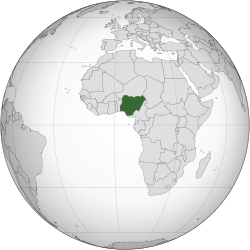| |||||||||||||||
| Motto: "Peace, Unity, Freedom"[1] (1966–1978) "Unity and Faith, Peace and Progress"[1] (1978–1979; 1983–1993; 1993–1999) | |||||||||||||||
| Anthem: Nigeria, We Hail Thee[1] (1966–1978) Arise, O Compatriots[1] (1978–1979; 1983–1993; 1993–1999) | |||||||||||||||
 | |||||||||||||||
| Capital | Lagos (1966–1979; 1983–1991) Abuja (1991–1993; 1993–1999) | ||||||||||||||
| Largest city | Lagos | ||||||||||||||
| Common languages |
| ||||||||||||||
| Religion | |||||||||||||||
| Government |
| ||||||||||||||
| Head of State/ President | |||||||||||||||
• 1966 | Johnson Aguiyi-Ironsib | ||||||||||||||
• 1966–1975 | Yakubu Gowon | ||||||||||||||
• 1975–1976 | Murtala Mohammed | ||||||||||||||
• 1976–1979 | Olusegun Obasanjo | ||||||||||||||
• 1983–1985 | Muhammadu Buhari | ||||||||||||||
• 1985–1993 | Ibrahim Babangida | ||||||||||||||
• 1993–1998 | Sani Abacha | ||||||||||||||
• 1998–1999 | Abdulsalami Abubakarc | ||||||||||||||
| Chief of Staff / Vice President | |||||||||||||||
• 1966 | Babafemi Ogundipe (first) | ||||||||||||||
• 1998–1999 | Mike Akhigbe (last) | ||||||||||||||
| Legislature | None (rule by decree) | ||||||||||||||
| Historical era | Cold War | ||||||||||||||
| 15 January 1966 | |||||||||||||||
• Unification Decree[2] | 24 May 1966 | ||||||||||||||
| 28 July 1966 | |||||||||||||||
• Federal system restored[3] | 31 August 1966 | ||||||||||||||
| 30 May 1967 | |||||||||||||||
| 30 July 1975 | |||||||||||||||
| 13 February 1976 | |||||||||||||||
| 1 October 1979 | |||||||||||||||
| 31 December 1983 | |||||||||||||||
| 27 August 1985 | |||||||||||||||
| 17 November 1993 | |||||||||||||||
| 29 May 1999 | |||||||||||||||
| Area | |||||||||||||||
| 1991[4] | 923,768 km2 (356,669 sq mi) | ||||||||||||||
| Population | |||||||||||||||
• 1991[4] | 88,514,501 | ||||||||||||||
| Currency | Nigerian pound (1966–1973) Naira (₦) (1973–1979; 1983–1993; 1993–1999) | ||||||||||||||
| Time zone | UTC+1 (WAT) | ||||||||||||||
| Drives on | left (until 2 April 1972)[5] right | ||||||||||||||
| ISO 3166 code | NG | ||||||||||||||
| |||||||||||||||
| Today part of | Nigeria Cameroone | ||||||||||||||
The military dictatorship in Nigeria was a period when members of the Nigerian Armed Forces held power in Nigeria from 1966 to 1999 with an interregnum from 1979 to 1983. The military was able to rise to power often with the tacit support of the elite through coups d'état. Since the country became a republic in 1963, there had been a series of military coups.
- ^ a b c d Ugorji, Basil (2012). From Cultural Justice to Inter-Ethnic Mediation: A Reflection on the Possibility of Ethno-Religious Mediation in Africa. Outskirts Press. p. 183. ISBN 9781432788353.
- ^ a b c Bah, Abu Bakarr (2005). Breakdown and Reconstitution: Democracy, the Nation-state, and Ethnicity in Nigeria (1st paperback ed.). Lanham, Maryland: Lexington Books. p. 108. ISBN 9780739109540.
- ^ a b c Gould, Michael (2011). The Struggle for Modern Nigeria: The Biafran War 1967–1970. I.B. Tauris. p. 116. ISBN 9780857730954.
- ^ a b Oshungade, I. O. (1995). "The Nigerian Population Statistics" (PDF). 1995 Directory of Nigerian Statisticians. 2: 58. Archived from the original (PDF) on 27 February 2013.
- ^ "Right-Hand/Left-Hand Driving Customs (mostly the change from Left to Right)". rammb.cira.colostate.edu.

